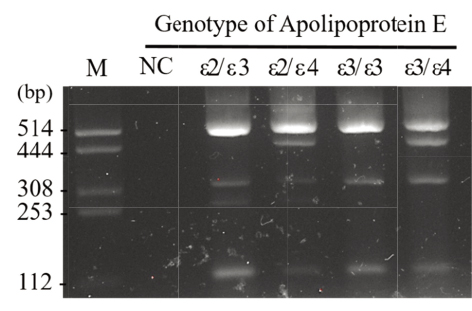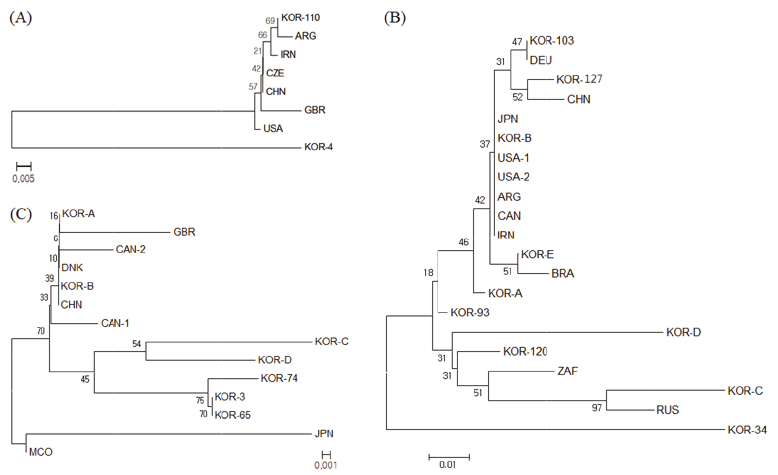J Bacteriol Virol.
2019 Mar;49(1):27-38. 10.4167/jbv.2019.49.1.27.
Apolipoprotein E Genotype and Expression Correlated with Hepatitis C Virus Genotype and Infection
- Affiliations
-
- 1Department of Clinical Laboratory Science, Catholic University of Pusan, Busan, Republic of Korea. kschang@cup.ac.kr
- 2Department of Clinical Laboratory Science, Shinsung University, Dangjin, Republic of Korea.
- 3Department of Clinical Laboratory Science, Chungbuk Health & Science University, Cheongwon, Republic of Korea.
- KMID: 2442585
- DOI: http://doi.org/10.4167/jbv.2019.49.1.27
Abstract
- The hepatitis C virus (HCV) is a globally prevalent human pathogen that causes persistent liver infections in most infected individuals. Several studies reported that HCV particles are enriched in apolipoprotein E (apoE) and that apoE is required for HCV infectivity and production. However, the relationship between apoE gene polymorphisms and HCV genotypes in patients with HCV is less well understood. The aim of this study was to investigate the association between apoE gene polymorphism and HCV genotypes in patients. The HCV genotypes were identified among the 124 patients infected with HCV, and the genetic characteristics of the HCV genotype were analyzed. In addition, the results of the clinical laboratory test were comparatively analyzed according to the classified genotypes. Both HCV 1b (n=80) and 2a (n=42) patients had higher AFP, AST, ALT, ALP, γ-GTP, apoB, and apoE values compared with the normal control group. In particular, apoB and apoE levels were statistically significantly higher in the HCV 2a patients (P<0.05) and apoE levels were significantly higher in the HCV 1b patients (P<0.000). According to the results the patients with HCV genotype 1b showed higher values of liver damage related indicators and apoB expression than the patients with HCV genotype 2a. The fat related indicators and apoE expression were not different between the two major HCV genotypes (2a and 1b). We anticipate that the apoE ε3 allele is the most common type in HCV genotype 1b (89.2%) and 2a (91.7%). As a result of apoE genotyping, we confirmed an association with HCV infection and the apoE ε3 allele. However, the ratios of the apoE ε3 allele among the patients with genotype 1b and 2a were similar to each other.
Keyword
MeSH Terms
Figure
Reference
-
1. Lanini S, Easterbrook PJ, Zumla A, Ippolito G. Hepatitis C: global epidemiology and strategies for control. Clin Microbiol Infect. 2016; 22:833–838.
Article2. Umar S, Yasir W, Muhammad A. Hepatitis B and hepatitis C viruses: a review of viral genomes, viral induced host immune responses, genotypic distributions and worldwide epidemiology. Asian Pac J Trop Dis. 2014; 4:88–96.
Article3. Shin HR, Kim JY, Kim JI, Lee DH, Yoo KY, Lee DS, et al. Hepatitis B and C virus prevalence in a rural area of South Korea: the role of acupuncture. Br J Cancer. 2002; 87:314–318.
Article4. Cho EJ, Jeong SH, Han BH, Lee SU, Yun BC, Park ET. Hepatitis C virus (HCV) genotypes and the influence of HCV subtype 1b on the progression of chronic hepatitis C in Korea: a single center experience. Clin Mol Hepatol. 2012; 18:219–224.
Article5. Hnatyszyn HJ. Chronic hepatitis C and genotyping: the clinical significance of determining HCV genotypes. Antivir Ther. 2005; 10:1–11.
Article6. Chang KS, Jiang J, Cai Z, Luo G. Human apolipoprotein e is required for infectivity and production of hepatitis C virus in cell culture. J Virol. 2007; 81:13783–13793.
Article7. Fierro NA, Gonzalez-Aldaco K, Torres-Valadez R, Martinez-Lopez E, Roman S, Panduro A. Immunologic, metabolic and genetic factors in hepatitis C virus infection. World J Gastroenterol. 2014; 20:3443–3456.
Article8. Felmlee DJ, Hafirassou ML, Lefevre M, Baumert TF, Schuster C. Hepatitis C virus, cholesterol and lipoproteins--impact for the viral life cycle and pathogenesis of liver disease. Viruses. 2013; 5:1292–1324.
Article9. Jiang J, Luo G. Apolipoprotein E but not B is required for the formation of infectious hepatitis C virus particles. J Virol. 2009; 83:12680–12691.
Article10. Jang ES, Won JE, Jung JI, Lee SH, Kim JW, Jeong SH. The effect of antiviral therapy on serum cholesterol levels in chronic hepatitis C. Gut Liver. 2011; 5:356–362.
Article11. Kim YS, Paeng JR, Woo JT, Kim SW, Yang IM, Kim JW, et al. Apolipoprotein E genotypes of normal and hyperlilpidemic subjects. J Korean Med Sci. 1993; 8:262–266.
Article12. Jo HJ, Park GN, Kim HR, Kim MJ, Shin KA, et al. Differences in Hematological Characteristics, Including Cholesterol and Apolipoprotein B and E, between Hepatitis B Virus and Hepatitis C Virus Patients in Korea. J Bacteriol Virol. 2016; 46:152–158.
Article13. Gause JW, Day RJ, Caraway CA, Poon WW, Rohn TT. Evaluation of Apolipoprotein E fragmentation as a biomarker for Alzheimer's disease. J Neurol Neurol Disord. 2017; 3:204.
Article14. Shon HS, Choi HY, Kim JR, Ryu SY, Lee YJ, Lee MJ, et al. Comparison and analysis of the prevalence of hepatitis C virus infection by region in the Republic of Korea during 2005–2012. Clin Mol Hepatol. 2015; 21:249–256.
Article15. Jeong SH, Jang ES, Choi HY, Kim KA, Chung W, et al. Current status of hepatitis C virus infection and countermeasures in South Korea. Epidemiol Health. 2017; 39:e2017017.
Article16. Seong MH, Kil H, Kim YS, Bae SH, Lee YJ, Lee HC, et al. Clinical and epidemiological features of hepatitis C virus infection in South Korea: a prospective, multicenter cohort study. J Med Virol. 2013; 85:1724–1733.
Article17. Messina JP, Humphreys I, Flaxman A, Brown A, Cooke GS, Pybus OG, et al. Global distribution and prevalence of hepatitis C virus genotypes. Hepatology. 2015; 61:77–87.
Article18. Bassendine MF, Sheridan DA, Bridge SH, Felmlee DJ, Neely RD. Lipids and HCV. Semin Immunopathol. 2013; 35:87–100.
Article19. Gastaminza P, Cheng G, Wieland S, Zhong J, Liao W, Chisari FV. Cellular determinants of hepatitis C virus assembly, maturation, degradation, and secretion. J Virol. 2008; 82:2120–2129.
Article20. Huang H, Sun F, Owen DM, Li W, Chen Y, Gale M Jr, et al. Hepatitis C virus production by human hepatocytes dependent on assembly and secretion of very low density lipoproteins. Proc Natl Acad Sci U S A. 2007; 104:5848–5853.
Article21. Icard V, Diaz O, Scholtes C, Perrin-Cocon L, Ramière C, Bartenschlager R, et al. Secretion of hepatitis C virus envelope glycoproteins depends on assembly of apolipoprotein B positive lipoproteins. PloS One. 2009; 4:e4223.
Article22. Price DA, Bassendine MF, Norris SM, Golding C, Toms GL, Schmid ML, et al. Apolipoprotein epsilon3 allele is associated with persistent hepatitis C virus infection. Gut. 2006; 55:715–718.
Article23. Gomaa HE, Mahmoud M, Saad NE, Saad-Hussein A, Ismail S, Thabet EH, et al. Impact of ApoE gene polymorphism on HCV therapy related outcome in a cohort of HCV Egyptian patients. J Genet Eng Biotechnol. 2018; 16:47–51.
Article24. Shin MH, Kim HN, Cui LH, Kweon SS, Park KS, Heo H, et al. The effect of apolipoprotein E polymorphism on lipid levels in Korean adults. J Korean Med Sci. 2005; 20:361–366.
Article
- Full Text Links
- Actions
-
Cited
- CITED
-
- Close
- Share
- Similar articles
-
- Rapid Changes in Serum Lipid Profiles during Combination Therapy with Daclatasvir and Asunaprevir in Patients Infected with Hepatitis C Virus Genotype 1b
- Current Status of Hepatitis E Virus Infection in Korea
- Association between Apolipoprotein E Genotype and Treatment Response in Chronic Hepatitis C
- Hepatitis C in Leprous Patients
- Prevalence of HBV Genotypes in Korean Patients with Chronic Hepatitis B



